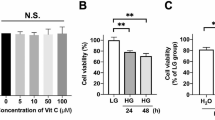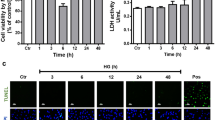Abstract
Intraocular generation of reactive oxygen species (ROS) with consequent oxidative stress has been shown to be a significant factor in the pathogenesis of many vision-impairing diseases such as cataracts and retinal degenerations. Previous studies have shown that pyruvate can inhibit such oxidative stress. This is attributable to its property of scavenging various ROS and consequently inhibiting many of the apparent toxic reactions such as lipid peroxidation and loss of tissue thiols. It is hence expected that ROS will have an adverse effect on tissue metabolism also. The present investigations were hence undertaken to study the possibility that while scavenging ROS, the compound could be effective also in preventing the inhibition of tissue metabolism as well. Since glycolysis constitutes the major bioenergetic source of the retina, the objective of the present studies was to ascertain if the effects of pyruvate are indeed reflected in the maintenance of this pathway even when the tissue is exposed to ROS. This hypothesis was examined by incubating retinal explants in ROS-generating medium in the absence and presence of pyruvate and measuring 3H2O generated from 5-3H glucose. In addition, the lactate generated was also measured. As hypothesized, ROS-induced inhibition of glycolysis indexed by the decrease in 3H2O as well as lactate formation was significantly prevented by pyruvate. This effect was also reflected by the elevation of NAD/NADH ratio, a major pacemaker of glycolysis.

Similar content being viewed by others
References
Young RW (1988) Solar radiation and age-related macular degeneration. Surv Ophthalmol 32:252–269
Kowluru RA, Kern TS, Engerman RL et al (1996) Abnormalities of retinal metabolism in diabetes or experimental galactosemia. III. Effects of antioxidants. Diabetes 45:1233–1237
Alvarado JA, Murphy CG, Polansky JR et al (1981) Age-related changes in human trabecular meshwork cellularity. Invest Ophthalmol Vis Sci 21:714–727
Kahn MG, Giblin FJ, Epstein DL (1983) Glutathione in calf trabecular meshwork and its relation to aqueous humor outflow facility. Invest Ophthalmol Vis Sci 24:1283–1287
Rao NA, Wu GS (2000) Free radical mediated photoreceptor damage in uveitis. Prog Retin Eye Res 19:41–68
Halliwell B, Gutteridge MC (1989) Free radicals in biology and medicine. Clarendon Press, Oxford, p 12
Pirie A, Van Heyningen R (1956) General metabolism of the retina. In: Pirie A, Van Heyningen R (eds) Biochemistry of the Eye. Charles C. Thomas, Illinois, pp 205–231
Little C, O’Brien PJ (1969) Mechanism of peroxide-inactivation of the sulfhydryl enzyme glyceraldehyde-3-phosphate dehydrogenase. Eur J Biochem 10:533–538
Axelsson K, Mannervik B (1983) An essential role of cytosolic thioltransferase in protection of pyruvate kinase from rabbit liver against oxidative inactivation. FEBS Lett 152:114–118
Winkler BS (1981) Glycolytic and oxidative metabolism in relation to retinal function. J Gen Physiol 77:667–692
Ames A 3rd, Li Y-Y, Heher EC, Kimble CR (1992) Energy metabolism of rabbit retina as related to function: high cost of Na transport. J Neurosci 12:840–853
Fenton HJH, Jones HO (1900) The oxidation of organic acids in presence of ferrous iron, Part I. J Chem Soc Trans 77:69–76
Holleman MAF (1904) Note on the action of oxygenated water on alpha-keto acids and 1, 2, dicetones. Recl Tran Chi Pays-bas Belq 23:169–172
Hohorst H-J (1965) l-(+)-lactate determination with lactic dehydrogenase and DPN. In: Bergmeyer HU (ed) Methods of enzymatic analysis. Academic Press, New York, pp 266–270
Williamson DH, Lund P, Krebs HA (1967) The redox state of free nicotinamide-adenine dinucleotide in the cytoplasm and mitochondria of rat liver. Biochem J 103:514–527
Obrosova IG, Drel VR, Kumagai AK, Szabo C, Pacher P, Stevens MJ (2006) Early diabetes-induced biochemical changes in the retina: comparison of rat and mouse models. Diabetologia 49:2525–2533
Richardson HB (1925) The capacity to oxidize carbohydrate as determined by the respiratory quotient. Monatsschrift Kinderheilkunde 24:588–593
Richardson HB, Levine SZ (1925) Clinical calorimetry. XXXIX. Exercise and the respiratory quotient in diabetes. J Biol Chem 66:161–183
Ervens B, Gligorovski S, Herrmann H (2003) Temperature dependent rate constants for hydroxyl radical reactions with organic compounds in aqueous solutions. Phys Chem Chem Phys 5:1811–1824
Sevag MG, Maiweg L (1934) Respiration mechanisms of pneumococcus. J Exp Med 60:95–105
Varma SD, Morris SM (1988) Peroxide damage to the eye lens in vitro: prevention by pyruvate. Free Rad Res Commun 4(5):283–290
Varma SD, Ramachandran S, Devamanoharan PS, Morris SM, Ali AH (1995) Prevention of oxidative damage to rat lens by pyruvate in vitro: possible attenuation in vivo. Curr Eye Res 14(8):643–649
Hegde KR, Varma SD (2005) Prevention of cataract by pyruvate in experimentally diabetic mice. Mol Cell Biochem 269(1–2):115–120
Hegde KR, Varma SD (2008) Prevention of oxidative stress to the retina by pyruvate. A preliminary report. Ophthalmologica 222(3):194–198
Wentzel P, Ejdesjo A, Eriksson UJ (2003) Maternal diabetes in vivo and high glucose in vitro diminish GAPDH activity in rat embryos. Diabetes 52:1222–1228
Zhao W, Devamanoharan PS, Varma SD (2000) Fructose induced deactivation of antioxidant enzymes: preventive effect of pyruvate. Free Rad Res 33:23–30
Noell WK, Walker VS, Kang BS et al (1966) Retinal damage by light in rats. Invest Ophthalmol 5:450–473
Acknowledgments
The authors are thankful for the financial support of NEI, NIH and Research to Prevent Blindness Inc, New York.
Author information
Authors and Affiliations
Corresponding author
Rights and permissions
About this article
Cite this article
Hegde, K.R., Kovtun, S. & Varma, S.D. Inhibition of glycolysis in the retina by oxidative stress: prevention by pyruvate. Mol Cell Biochem 343, 101–105 (2010). https://doi.org/10.1007/s11010-010-0503-9
Received:
Accepted:
Published:
Issue Date:
DOI: https://doi.org/10.1007/s11010-010-0503-9




